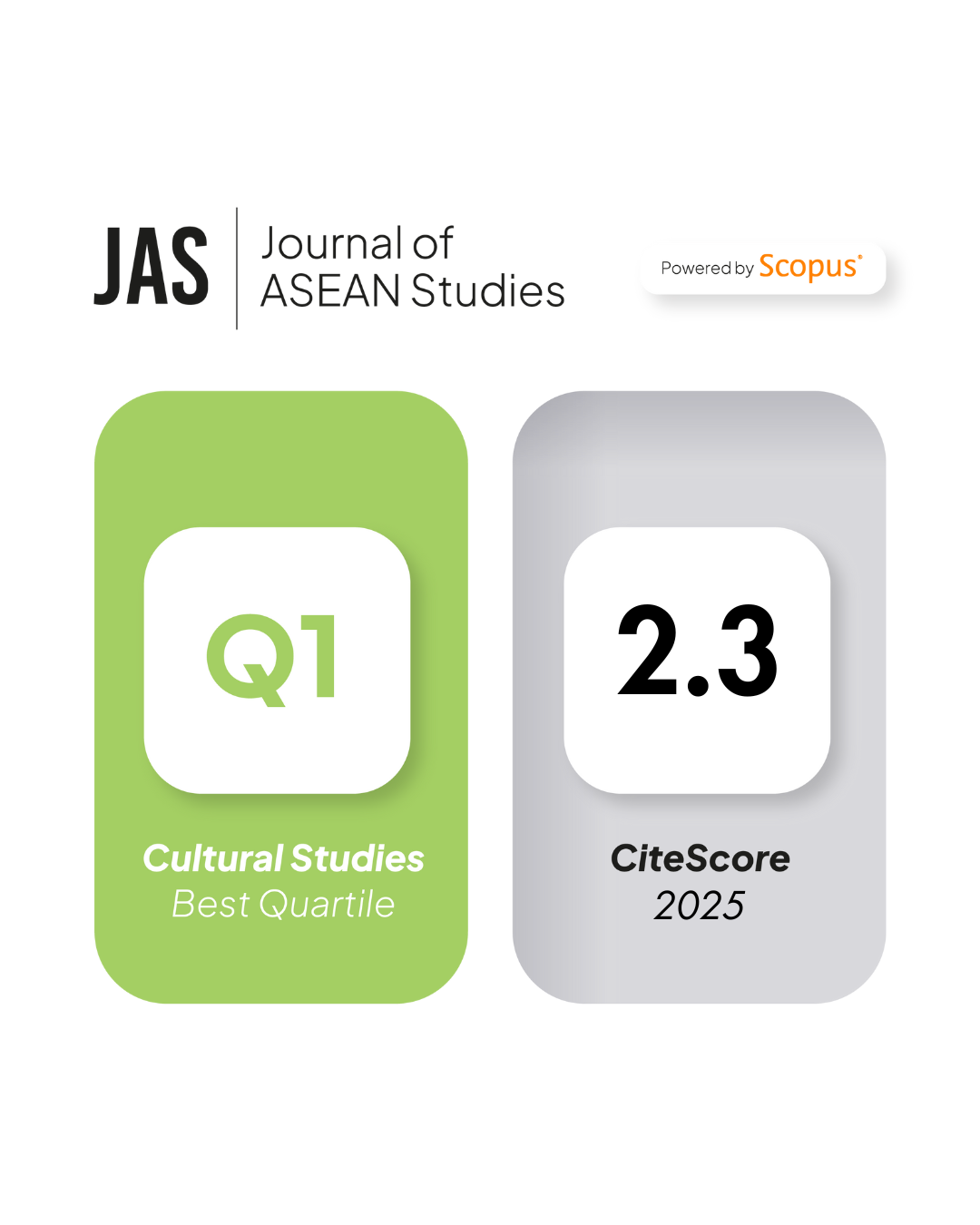What Does ASEAN Economic Community Bring to Older Workers? Examining Inequality in Old Age in Thailand’s Fast-Ageing Society
DOI:
https://doi.org/10.21512/jas.v7i1.5590Keywords:
inequality, labour market, old age, regional integrationAbstract
The ASEAN Economic Community is envisaged to promote economic integration initiatives to create a single market across Southeast Asian member countries. It is acknowledged that the intergovernmental initiatives need to be accommodative to national and regional contexts. Thailand, as a pivotal and active partnership, endeavours to facilitate economic transformation and regional integration within the ASEAN and cope with population ageing in Thai society. Since Thailand has been the third most rapidly ageing country in the world, demographic changes pose new challenges for how to achieve persistent economic growth, productive employment and decent work. This article is based on a qualitative approach to investigate the emergent inequality within and across age cohorts shaped by the AEC structural forces, as well as utilizes reliable secondary data to formulate argumentation, including academic publications, policy analysis, scientific reports. We are particularly concerned about the heterogeneity and poverty in old age from the perspective of cumulative advantages/disadvantages. In conclusion, this article suggests policy recommendations of mitigating inequality in old age and advocates a critical lens to examine how political economic structure shapes older individuals in the labour market.
References
ASEAN Secretariat. (2004). ASEAN Accelerates Integration of Priority Sectors. Retrieved from https://asean.org/?static_post=media-release-asean-accelerates-integration-of-priority-sectors
Bano, S., & Tabbada, J. (2017). The employment effects of regional integration: A case study of the Association of Southeast Asian Nations (ASEAN). Paper presented at the New Zealand Agricultural and Resource Economics Society (NZARES) Conference, Rotorua, New Zealand. NZARES.
Barbin, R. R., & Nicholls, P. (2013). Embracing an ASEAN economic community: Are Thai students ready for the transition?. AU-GSB e-journal, 6(2), 3-10.
Bar-Haim, E., & Blank, C. (2019). Second-chance alternatives and maintained inequality in access to higher education in Israel. Social Inclusion, 7(1), 28-37.
Crystal, S., & Shea, D. (1990). Cumulative advantage, cumulative disadvantage, and inequality among elderly people. The Gerontologist, 30(4), 437-443.
Crystal, S., Shea, D. G., & Reyes, A. M. (2017). Cumulative advantage, cumulative disadvantage, and evolving patterns of late-life inequality. The Gerontologist, 57(5), 910-920.
Dannefer, D. (1987). Aging as intracohort differentiation: Accentuation, the Matthew effect, and the life course. Sociological Forum, 2(2), 211-236.
Dannefer, D. (2003). Cumulative advantage/disadvantage and the life course: Cross-fertilizing age and social science theory. The Journals of Gerontology Series B: Psychological Sciences and Social Sciences, 58(6), 327-337.
DiPrete, T. A., & Eirich, G. M. (2006). Cumulative advantage as a mechanism for inequality: A review of theoretical and empirical developments. Annual Review of Sociology, 32, 271-297.
Dixon, S. (2003). Implications of population ageing for the labour market. Labour Market Trends, 111(2), 67-76.
Dudzik, D. L., & Nguyen, Q. T. N. (2015). Vietnam: Building English competency in preparation for ASEAN 2015. ASEAN Integration and the Role of English Language Teaching. Phnom Penh: IDP, 41-70.
Elman, C., & O'Rand, A. (1998). Midlife work pathways and educational entry. Research on aging, 20(4), 475-505.
Fujioka, R., & Thangphet, S. (2008). Decent work for older persons in Thailand. Retrieved from International Labour Organization website: https://www.ilo.org/wcmsp5/groups/public/---asia/---ro-bangkok/documents/publication/wcms_103920.pdf
HelpAge (n.d.). Ageing population in Thailand. Retrieved from http://ageingasia.org/ageing-population-thailand/
Hudson, R. B. (2016). Cumulative advantage and disadvantage: Across the life course, across generations. Public Policy & Aging Report, 26(2), 39-41.
Knodel, J., & Chayovan, N. (2008, December). Population ageing and the well-being of older persons in Thailand: Past trends, current situation and future challenges. Retrieved from UNFPA Thailand website: https://deepblue.lib.umich.edu/bitstream/handle/2027.42/83331/Paper_No_5.pdf?sequence=1&isAllowed=y
Kohn, M. L., & Schooler, C. (1984). Work and personality: An inquiry into the impact of social stratification. Contemporary Sociology, 13(3), 356-358.
Kuosuwan, B. (2016). The readiness of English communication skills of tourism employees in Bangkok for entering the ASEAN community. International Journal of Environmental and Science Education, 11(18), 12903-12907.
Lai, H. C. (2016). Free trade and employment in the ASEAN: From theory to empirical. International Relations, 4(7), 465-472.
Lee, H., Park, N., & Hwang, Y. (2015). A new dimension of the digital divide: Exploring the relationship between broadband connection, smartphone use and communication competence. Telematics and Informatics, 32(1), 45-56.
Mayer, S. E. (1997). What money can't buy: Family income and children's life chances. Harvard University Press.
Mincer, J. (1991). Education and unemployment (NBER No. 3838). US: National Bureau of Economic Research.
NESDB (2016). The twelfth national economic and social development plan (2017-2021). Retrieved from https://www.nesdb.go.th/nesdb_en/ewt_w3c/ewt_dl_link.php?nid=4345
Nobnorb, P., & Fongsuwan, W. (2015). Asean and thai rubber industry labor mobility determinants: A structural equation model. Research Journal of Business Management, 9(2), 404-421.
OECD/ILO (2017), How immigrants contribute to Thailand’s economy. ILO, Geneva/OECD Publishing, Paris. Retrieved from http://dx.doi.org/10.1787/9789264287747-en
O'Rand, A. M. (1996). The precious and the precocious: Understanding cumulative disadvantage and cumulative advantage over the life course. The Gerontologist, 36(2), 230-238.
PATA (2017, May 12). World Economic Forum: ASEAN is harnessing the transformative technologies of the Fourth Industrial Revolution. Retrieved from https://www.pata.org/world-economic-forum-asean-is-harnessing-the-transformative-technologies-of-the-fourth-industrial-revolution/#sthash.IQ1uGQog.dpuf
Petri, P. A., Plummer, M. G., & Zhai, F. (2012). ASEAN economic community: A general equilibrium analysis. Asian Economic Journal, 26(2), 93-118.
Ponomarenko, V. (2016). Cumulative disadvantages of non-employment and non-standard work for career patterns and subjective well-being in retirement. Advances in Life Course Research, 30, 133-148.
Suanmali, S., & Saengsathien, A. (2014). Factors affecting labor mobility within ASEAN: An empirical study on Thai engineers. In Proceedings of the International Conference on Information and Communication Technology for Embedded Systems (pp. 1-6). Ayutthaya, Thailand.
UNDP (2013, March 15). UNDP Report lists Thailand among Asia’s fastest growing. Retrieved from http://www.th.undp.org/content/thailand/en/home/presscenter/pressreleases/2013/03/15/undp-report-lists-thailand-among-asia-s-fastest-growing.html
Vicheth, S. E. N. (2012). Cambodia’s higher education structure and the implications of the 2015 ASEAN economic community. CDRI's Cambodia Annual Development Review, 24-32.
Vineles, P. (2017). ASEAN connectivity: Challenge for an integrated ASEAN community. (RSIS Commentaries, No. 010). RSIS Commentaries. Singapore: Nanyang Technological University.
Walker, A. (1981). Towards a political economy of old age. Ageing & Society, 1(1), 73-94.
Willson, A. E., Shuey, K. M., & Elder, Jr, G. H. (2007). Cumulative advantage processes as mechanisms of inequality in life course health. American Journal of Sociology, 112(6), 1886-1924.






















